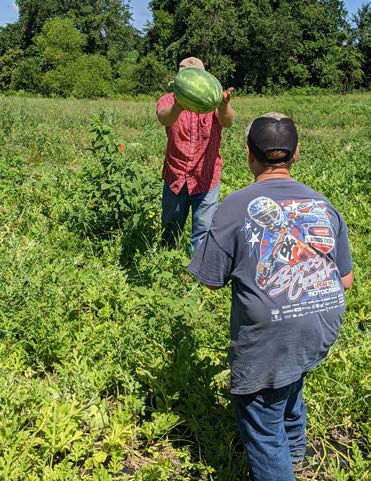Evaluation of Grafted Watermelon for Fusarium Wilt Management

Ben Beale-Extension Agent, St. Mary’s County
Alan Leslie-Extension Agent, Charles County
Haley Sater-Extension Agent, Wicomico County
Fusarium Wilt, caused by the soil borne pathogen Fusarium oxysporum f. sp. niveum is becoming more problematic in seedless watermelon production in Southern Maryland.
Unfortunately, there are few effective management options for this soil borne disease. New races of fusarium wilt are now present in the area that can overcome traditional cultivar resistance. Effective fungicides are limited and do not provide season long control at labeled rates. In many cases, once a field is infested with fusarium wilt, watermelon production is no longer a viable option. A technique that has been effective in other areas is grafting of susceptible cultivars onto fusarium resistant rootstocks of interspecific hybrid squash or citron species. Watermelon grafting is more difficult than tomato grafting and is normally done by outside companies who specialize in the technique. During the 2020 and 2021 growing season, a field research and demonstration trial was conducted at several farms with a history of fusarium wilt to evaluate the efficacy of grafting for fusarium management. A second study was undertaken in the 2022 growing season to evaluate the optimum plant population for grafted watermelon.
During the 2022 season, a population study was conducted at two locations-one at a private farm in St. Mary’s County and the other at the UMD Lower Eastern Shore Research and Education Center (LESREC). Both sites had a history of watermelon fusarium wilt. Seedless Fascination watermelon plants grafted to Carolina Strongback (CSB) citron rootstock were planted at each location with plant spacing of 4ft, 6ft and 8ft between plants and row spacing of 54 to 60 inches. Plots were intensively managed utilizing black plastic mulch, drip tape, fertigation and crop protectants as needed. Each site utilized a complete block randomized design with four replications. The study utilized SP-6 pollenizer plants grafted to CSB rootstock. Tri-Hishtil (25 School House Rd, Mills River, NC 28759 (P) 828-620-5020), a commercial firm in North Carolina specializing in grafting donated the plants for the trial. Data on yield, fruit size, fruit quality and canopy cover was collected.

(LESREC). Both sites had a history of watermelon fusarium wilt. Seedless Fascination watermelon plants grafted to Carolina Strongback (CSB) citron rootstock were planted at each location with plant spacing of 4ft, 6ft and 8ft between plants and row spacing of 54 to 60 inches. Plots were intensively managed utilizing black plastic mulch, drip tape, fertigation and crop protectants as needed. Each site utilized a complete block randomized design with four replications. The study utilized SP-6 pollenizer plants grafted to CSB rootstock. Tri-Hishtil (25 School House Rd, Mills River, NC 28759 (P) 828-620-5020), a commercial firm in North Carolina specializing in grafting donated the plants for the trial. Data on yield, fruit size, fruit quality and canopy cover was collected.
Summary of Results: The six foot spacing resulted in the highest yields and the highest fruit count at both sites. While this is only one year’s worth of data and yields were below average due to the growing season, it appears that the 6 foot spacing is ideal for grafted watermelon. This spacing requires considerably less plants than conventional watermelon spacing. The study also found that fruit size also increased with greater plant spacing, as was expected.

Back to Roots in Research LESREC